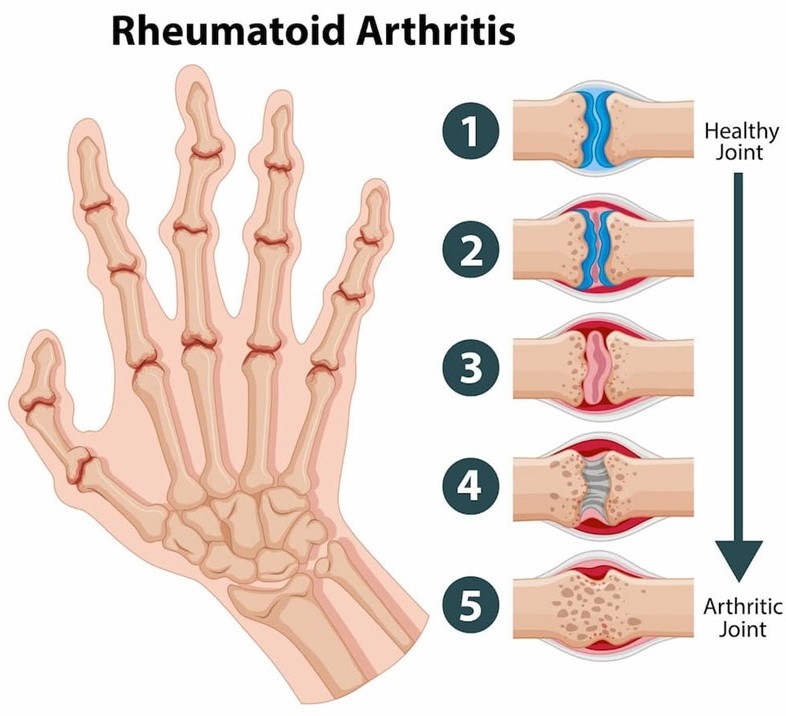HYPERTHYROIDISM (THYROTOXICOSIS)
Hyperthyroidism, also called thyrotoxicosis, is a hypermetabolic state caused by excess production of thyroid hormones. The condition is more frequent in females and is associated with rise in both T3 and T4 levels in blood, though the increase in T3 is generally greater than that of T4.
ETIOPATHOGENESIS
Hyperthyroidism may be caused by many diseases, but three most common causes are: Graves’disease (diffuse toxic goitre), toxic multinodular goitre and a toxic adenoma.
Less frequent causes are hypersecretion of pituitary TSH by a pituitary tumour, hypersecretion of TRH, thyroiditis, metastatic tumours of the thyroid, congenital hyperthyroidism in the newborn of mother with Graves’ disease, excessive doses of thyroid hormones or iodine called Jod-Basedow disease.
CLINICAL FEATURES
- The usual symptoms are emotional instability, nervousness, fatigue, weight loss, heat intolerance, perspiration, menstrual disturbances and fine tremors of the outstretched hands.
- Cardiac manifestations in the form of tachycardia, palpitations and cardiomegaly.
- Weakness of skeletal muscles and osteoporosis.
- Typical eye changes in the form of exophthalmos.
Serum levels of T3 and T4 are elevated but TSH secretion is usually inhibited.
A sudden spurt of hyperthyroidism termed ‘thyroid storm’ or ‘thyroid crises’ may occur in patients who have undergone subtotal thyroidectomy before adequate control of hyperthyroid state, or in a hyperthyroid patient under acute stress, trauma, and with severe infection. These patients develop high grade fever, tachycardia, cardiac arrhythmias, and coma and may die of congestive heart failure or hyperpyrexia.
HYPOTHYROIDISM
Hypothyroidism is a state resulting from inadequate production of thyroid hormones for prolonged periods.
Hypothyroidism, depending upon the age at onset of disorder, are divided into 2 forms:
1. Cretinism or congenital hypothyroidism is the development of severe hypothyroidism during infancy and childhood.
2. Myxoedema is the adulthood hypothyroidism.
CRETINISM
A cretin is a child with severe hypothyroidism present at birth or developing within first two years of postnatal life. This is the period when brain development is taking place; in the absence of treatment the child is both physically and mentally retarded.
The word ‘Cretin’ is derived from the French, meaning Christlike because these children are so mentally retarded that they are incapable of committing sins.
ETIOPATHOGENESIS
The causes of congenital hypothyroidism are as follows:
1. Developmental anomalies e.g. thyroid agenesis and ectopic thyroid.
2. Genetic defect in thyroid hormone synthesis.
3. Foetal exposure to iodides and antithyroid drugs.
4. Endemic cretinism in regions with endemic goitre due to dietary lack of iodine.
CLINICAL FEATURES
The features exhibited by a cretin are:
- Slow to thrive, poor feeding, constipation, dry scaly skin, hoarse cry, and bradycardia.
- As the child ages, following symptoms are also observed-
- Impaired skeletal growth and consequent dwarfism, round face, narrow forehead, widely set eyes, flat and broad nose, and protuberant abdomen. Neurological features such as deaf mutism, spasticity and mental deficiency are more evident in sporadic cretinism.
There occurs a rise in TSH level and fall in T3 and T4 levels.
MYXOEDEMA
The adult-onset severe hypothyroidism causes myxoedema. It causes non-pitting oedema due to accumulation of hydrophilic mucopolysaccharides in the ground substance of dermis and other tissues.
ETIOPATHOGENESIS
There are several causes of myxoedema listed below but the first two are the most common causes:
1. Ablation of the thyroid by surgery or radiation.
2. Autoimmune thyroiditis.
3. Endemic or sporadic goitre.
4. Hypothalamic-pituitary lesions.
5. Thyroid cancer.
6. Prolonged administration of antithyroid drugs.
7. Mild developmental anomalies and dyshormonogenesis.
CLINICAL FEATURES
The main features are cold intolerance, mental and physical lethargy, constipation, slowing of speech and intellectual function, puffiness of face, loss of hair and altered texture of the skin.
There is low serum T3 and T4 levels and elevated TSH levels as in the case of cretinism but cases with suprathyroid lesions (hypothalamic-pituitary disease) have low TSH levels.
GOITRE
The term goitre is defined as thyroid enlargement caused by compensatory hyperplasia and hypertrophy of the follicular epithelium in response to thyroid hormone deficiency. The end-result of this hyperplasia is generally a euthyroid state (normal thyroid gland function) though at some stages there may be hypo- or hyperthyroidism.
CAUSES
- Dietary lack of iodine.
- Genetic defect in thyroid hormone synthesis.
- Inborn errors of iodine metabolism.
- Goitrogens- Goitrogens are substances which interfere with the synthesis of thyroid hormones.
- The end-stage of long-standing simple goitre results in nodular goitre.
PATHOGENESIS OF GOITRE
The fundamental defect is deficient production of thyroid hormones mainly due to dietary lack of iodine. Deficient thyroid hormone production causes excessive TSH stimulation which leads to hyperplasia of follicular epithelium as well as formation of new thyroid follicles. Cyclical hyperplastic stage followed by involution stage result in simple goitre. Repeated and prolonged changes of hyperplasia result in continued growth of thyroid tissue while involuted areas undergo fibrosis, thus leading to nodular goitre.



REFERENCE
Harsh Mohan; Text book of Pathology; 6 th edition; India; Jaypee Publications; 2010








